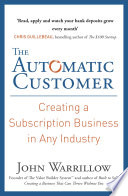

The book introduces the concept of the subscription economy, which is a shift from traditional one-time purchase models to recurring revenue streams. This model allows businesses to generate predictable income, enhance customer loyalty, and adapt to changing consumer preferences. By adopting subscription-based models, companies can create lasting relationships with customers, leading to increased lifetime value and reduced churn. The author emphasizes that businesses must understand their customers' needs and tailor their offerings accordingly. This shift not only benefits businesses but also aligns with modern consumer behavior, where customers prefer flexibility and convenience.
Continue readingThe author categorizes different types of subscription models, providing a framework for businesses to explore. These include curated subscriptions, replenishment subscriptions, access subscriptions, and more. Each model serves different customer needs and market segments. For instance, curated subscriptions appeal to consumers looking for curated experiences, while replenishment subscriptions cater to those who require regular supplies of essential items. By understanding these models, businesses can choose the right approach to meet their target audience's preferences and optimize their offerings for maximum engagement and retention.
Continue readingTo establish a successful subscription business, the author outlines key steps, including identifying a target market, developing a unique value proposition, and creating an engaging customer experience. Businesses must focus on providing value that resonates with their audience, ensuring that customers perceive the subscription as worthwhile. This involves not only the product or service itself but also the overall experience, including customer service, ease of use, and community engagement. The author stresses that building trust and delivering consistent value are crucial to retaining subscribers and fostering long-term relationships.
Continue readingA significant focus of the book is on the importance of nurturing customer relationships for subscription-based businesses. The author discusses strategies for enhancing customer engagement, such as personalized communication, loyalty programs, and community building. Retention is emphasized over acquisition, as retaining existing customers is often more cost-effective than acquiring new ones. The author provides insights into measuring customer satisfaction and utilizing feedback to improve offerings. By prioritizing customer relationships, businesses can create a loyal subscriber base that drives sustainable growth.
Continue readingThe book highlights the role of technology in facilitating and scaling subscription businesses. The author discusses various tools and platforms that can automate processes, manage subscriptions, and analyze customer data. These technologies enable businesses to streamline operations, enhance customer experiences, and make data-driven decisions. The author encourages businesses to leverage analytics to understand subscriber behavior and preferences, allowing for more targeted marketing and personalized offerings. Embracing technology is portrayed as essential for staying competitive in the evolving subscription landscape.
Continue readingThe author emphasizes the significance of key performance indicators (KPIs) in managing subscription businesses. Metrics such as customer acquisition cost (CAC), lifetime value (LTV), churn rate, and monthly recurring revenue (MRR) are crucial for assessing the health of a subscription model. By tracking these metrics, businesses can identify trends, optimize their strategies, and make informed decisions. The author advises against focusing solely on revenue growth; instead, a holistic view of metrics is necessary for sustainable success. Understanding the relationship between these metrics helps businesses fine-tune their approaches and drive profitability.
Continue readingThe book concludes with a discussion of emerging trends in subscription models and how businesses can adapt to stay ahead. The author explores the impact of changing consumer behaviors, technological advancements, and market dynamics on subscription offerings. As more industries embrace subscription models, businesses must innovate and differentiate themselves to capture market share. The author encourages readers to stay informed about trends and be open to evolving their strategies. Adapting to future changes is crucial for long-term success in the subscription economy.
Continue reading